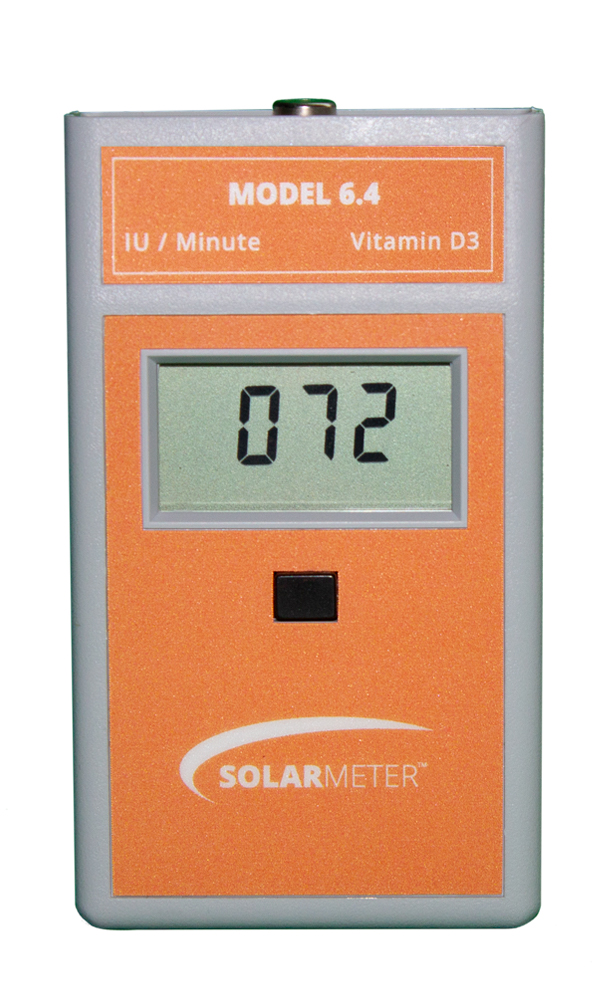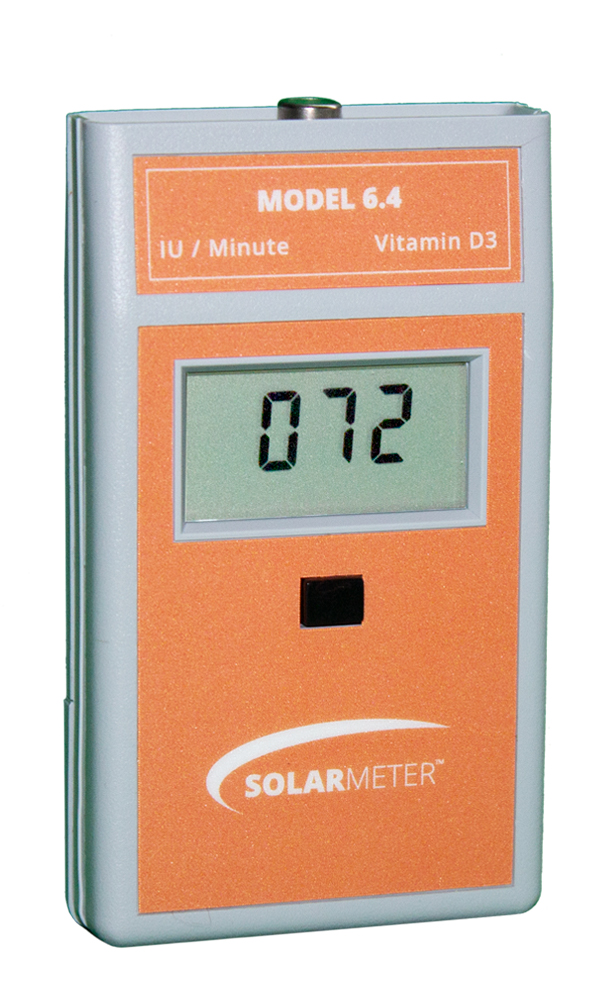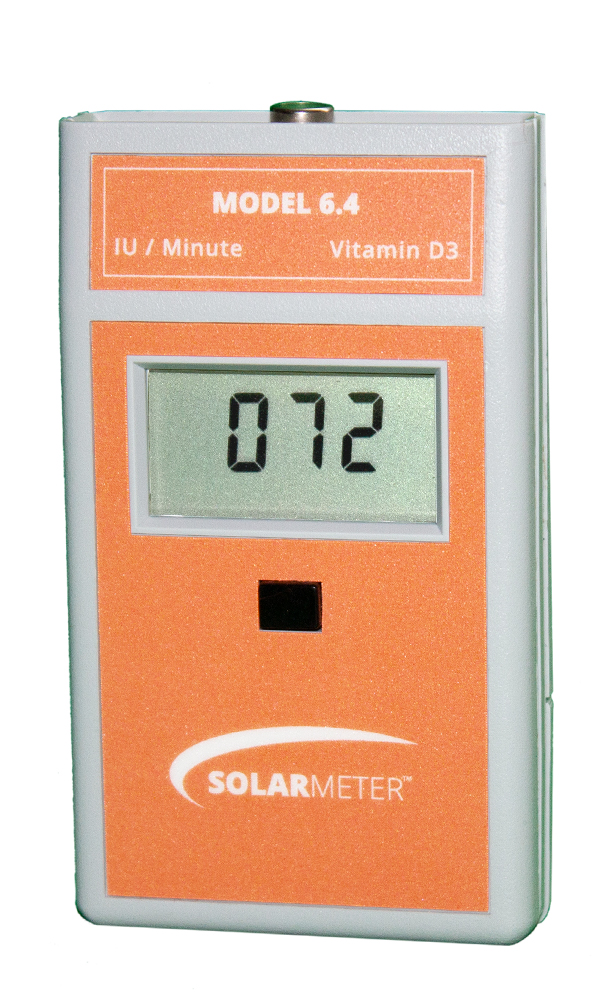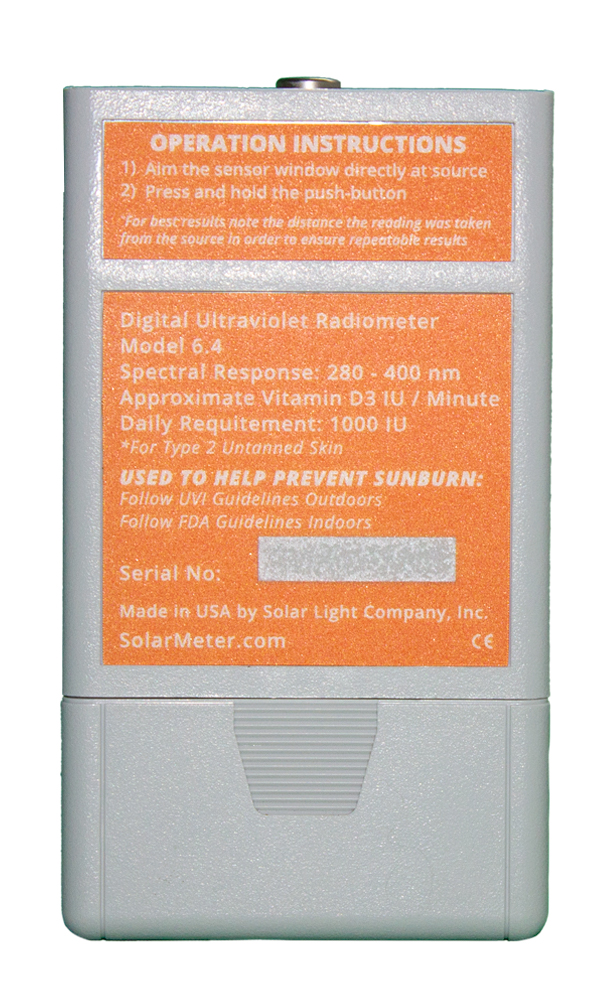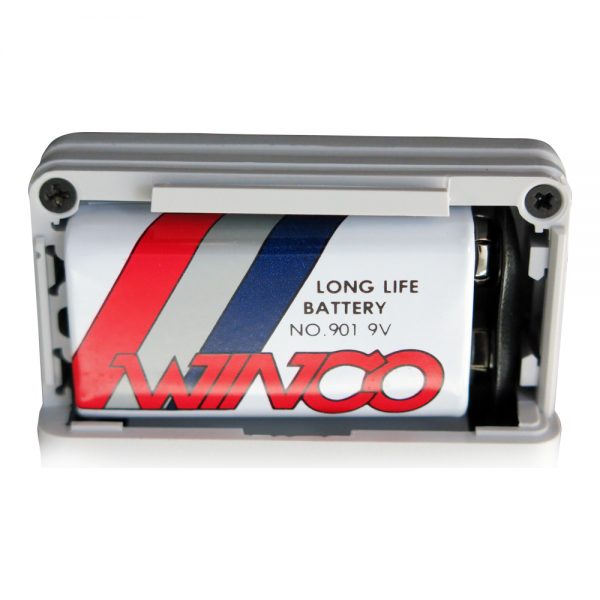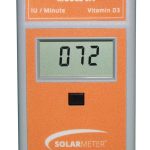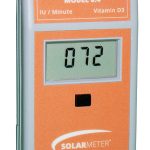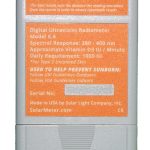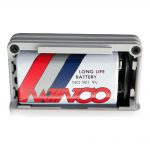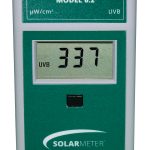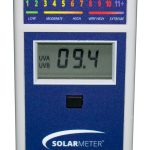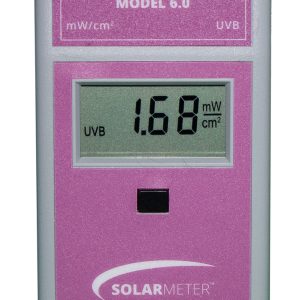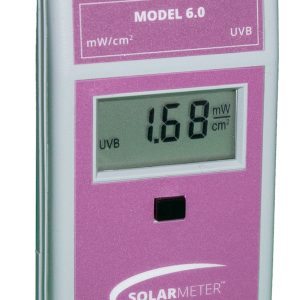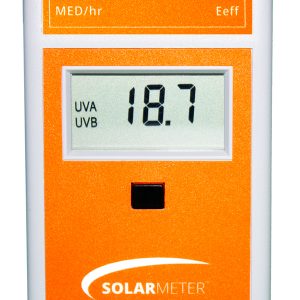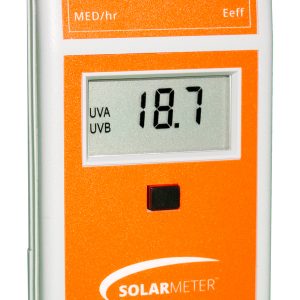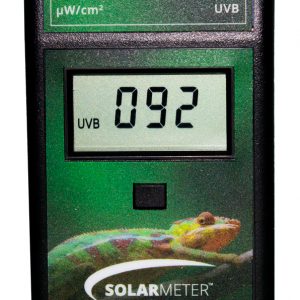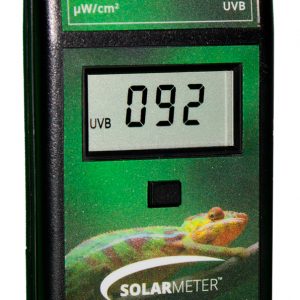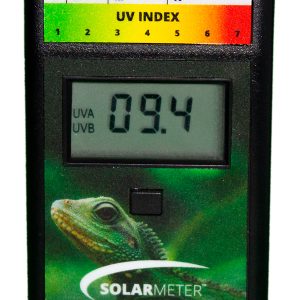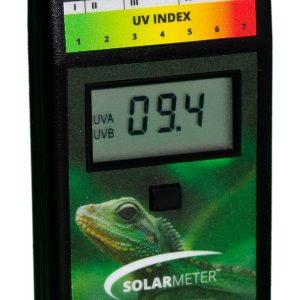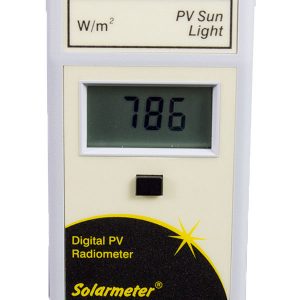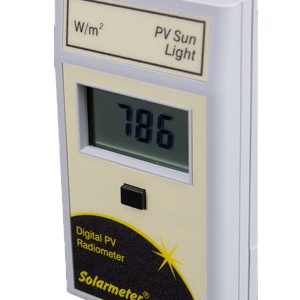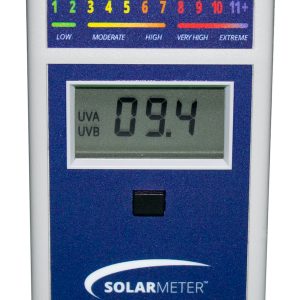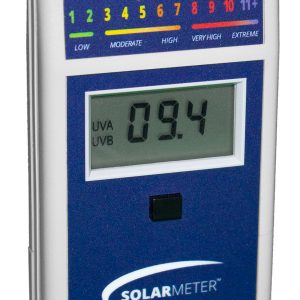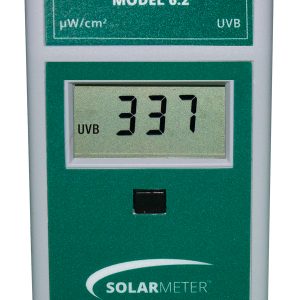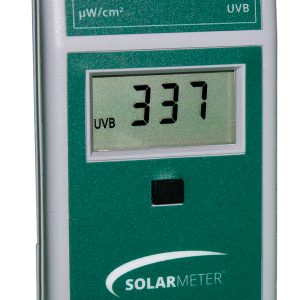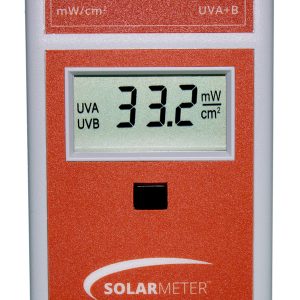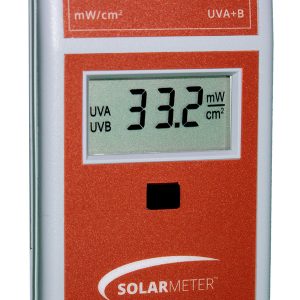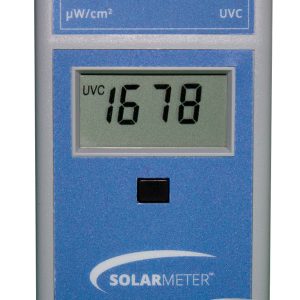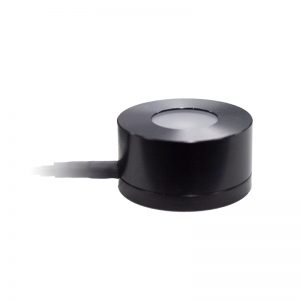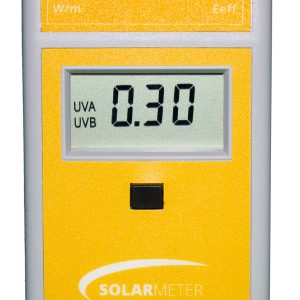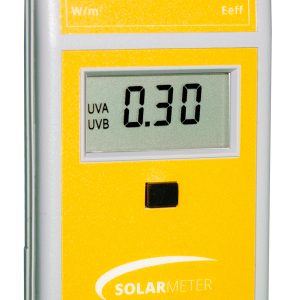Solarmeter® Model 6.4 Vitamin D3 Meter
$249.00
Features:
- Compact, Handheld, and Durable
- Simple Single-Button Operation
- NIST Traceable Accuracy
- LCD Display
- Made In USA
Applications:
- Monitoring of Vitamin D Production In IU/min
- Monitoring UV Lamp Intensity and Aging
- Comparison Of Sources In Terms Of Vitamin D Production
- Measuring Solar Intensity In Terms Of Vitamin D Production
- Description
- Additional information
- Videos
- Downloads
Description
| Solarmeter® Specifications | |
| Model | 6.4 |
| Irradiation Range | 0-1999 IU/min |
| Response | 280-400 nm Diffey Erythemal Action Spectrum |
| Resolution | 1 IU/Min |
| Conversion Rate | 3.0 Readings/Sec |
| Display | 3.5 Digit LCD |
| Digit Size | 0.4 (in) / 10.2 (mm) high |
| Operational Temperature | 32°F to 90°F / 0°C to 37.8°C |
| Operational Humidity | 5% to 80% RH |
| Accuracy | ±10% REF.NIST |
| Dimensions |
4.2L x 2.4W x 0.9D (in) / 106.7L x 61W x 22.9D (mm) |
| Weight | 4.5 (oz) / 128 (g) Including Battery |
| Power Source | 9-Volt DC Battery |
| Lens | UV Glass with Diffuser |
| Diffuser | Teflon |
| Agency Approval | CE Mark |
Radiometer:
- Peak ultraviolet response
- bandwidth: 280-298 nm
- Total UVR response: <280-400nm, Diffey EAS
- Display: 3.5 digit LCD
- Resolution: 1 IU/minute
- Power Source: 9V DC battery
- Accuracy: Eeff ± 10% ref NIST. Vit D3 approximate.
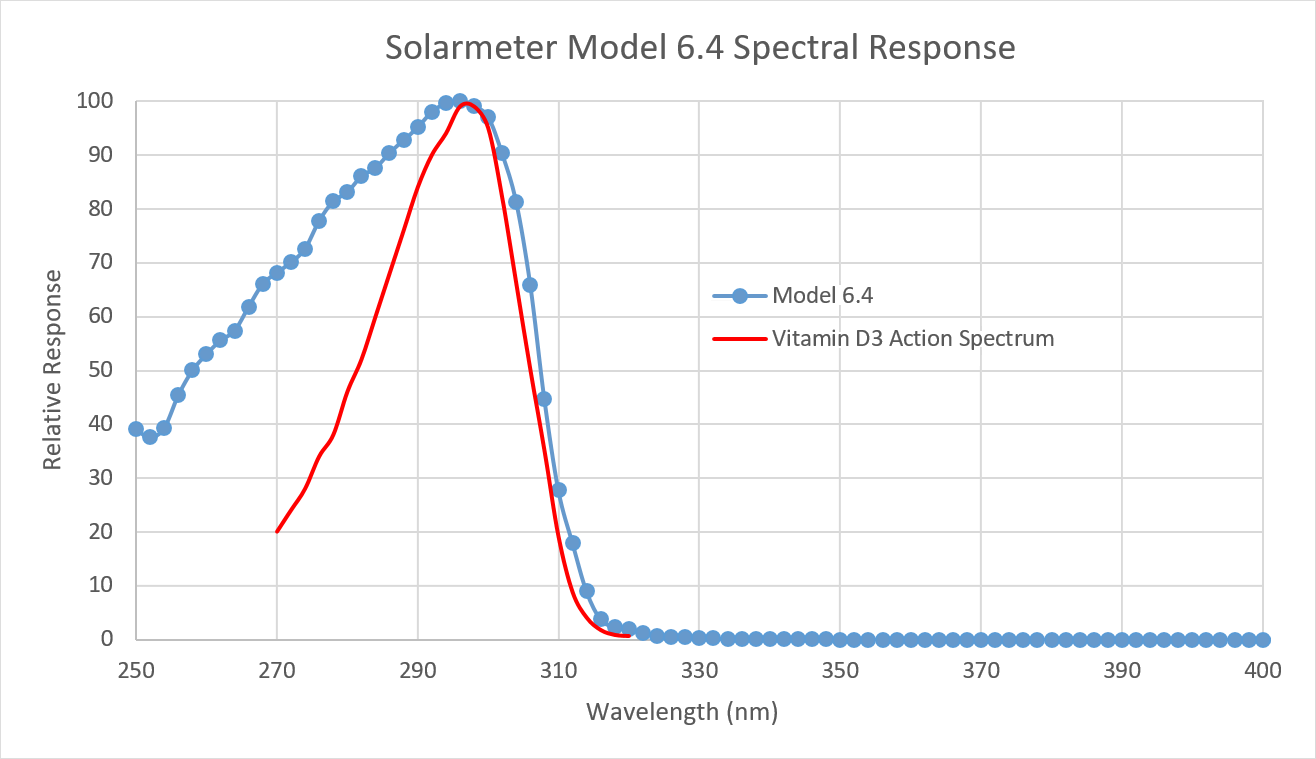
Outdoors, take the meter reading pointing straight up for global normal (direct plus diffuse) irradiance. Indoors, take the meter reading at “body position” distance from the UVR lamp array. You will note outdoors that clear-sky solar zenith angle (SZA) has the largest effect on meter reading being highest during summer noon times. Sky clarity (deep blue) and altitude will also influence readings higher. Indoors, the percent UVB and wattage of UVR lamps have the largest effect on readings. They are typically 3-5 times higher than solar noon values.
The fundamental basis of this meter’s calibration seeks to equate 1 minimal erythemal dose (MED) with 1000 IU of Vitamin D3 for skin type 2 at 10% body exposure (face and lower arms) with no base tan or SPF at age 20 average young adult. Interactive excel spreadsheet “utility” software will be provided with each meter to adjust the above parameters and dose duration based on your personal metrics. See screen shot of this utility below:
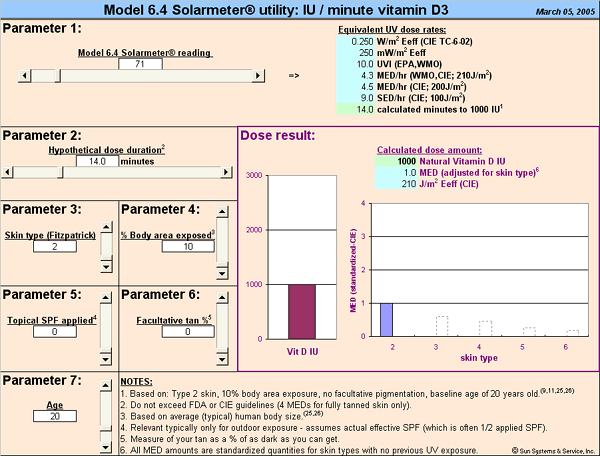
Proper Usage
Proper usage of Solarmeter Vitamin D3 IU per Minute International Units (IU) of natural vitamin D3 (converted from 7-DHC) per minute of ultraviolet B exposure instructions:
This instrument is designed for both outdoor solar measurement and indoor UVR appliance measurement. The sensor/detector response follows the Diffey Erythemal Action Spectrum (EAS) effective irradiance (Eeff), and thus remains accurate for various spectral power distributions. Eeff is used here as a proxy for Vitamin D action spectrum weighted irradiance (Deff), which is very similar but cuts off at 330 nm. Spectral radiometer tests have shown Eeff and Deff to be virtually linearly proportional outdoors ± ~4 hours from solar noon, and indoors for most commonly used UVR lamps.
Sensor
Silicon Carbide (SiC) photodiode with interference filter and teflon in UV glass diffuser cap.
The formula constants embedded in the UTILITY conversions of meter readings with IU and Eeff dose rates are:
1000 IU = 1 Med.
1 IU/min = 1/1000 Med/min (or 0.06 Med/hr, which = 1/16.67 MED/hr)
1 Med/hr = 2.33 UVI and 1 Med/hr = 16.67 IU/min.
Thus the conversion constant for IU/min to UVI is 16.67 / 2.33 = 7.1 UVI. Formulas for other parameters (skin type, tan level, age, etc are footnoted and available on request).
How to use the meter:
For the casual user seeking about 1000 IU from face/arms exposure, there is no need to use the spreadsheet parameters. Simply point the meter at UV source and divide the reading into 1000 for minutes of exposure. Done. Cautionary note: if you are white type 2 skin (usually burns, sometimes tans) start out at 50-75% of calculated minutes until your tolerance to UVR increases after about 4 exposures. If you are higher skin type and/or have a base tan, you will synthesize less than 1000 IU.
For the user seeking more accurate dose levels, please use the Utility and determine appropriate dose level for your particular metrics. Here is a “by the numbers” procedure:
1. Set meter reading in parameter 1.
2. Set hypothetical dose to same minutes as shown in parameter 1 sidebar.
3. Set parameter 2 skin type (note IU decrease as skin type increases)
4. Set % body (note IU increase as % body exposure increases above 10%)
5. Set SPF if any (note IU large decrease as SPF increases above 0)
6. Set % tan (note IU decrease as tan level increases)
7. Set age (note IU decrease above and below baseline 20yr old)
8. Return to parameter 2 and adjust dose duration up or down to see approximate IU for exposure session
Take care to keep dose below 1 MED for type 2 with 0% tan. Note that dose duration cannot be set above 4 MEDs for fully tanned sunburn avoidance purposes. Also note that after 2 MEDs the amount of IU will stop increasing as the body is much less able to synthesize cumulative Vit D3 above ~1.5 MEDs.
Battery operation voltage is 9V down to 6.5V. Below 6.5V the LCD numbers will begin to dim, indicating the need for battery replacement. Under “typical” service load, the battery should last about 2 years.
Fitzpatric skin types: please see http://www.dermnetnz.org/reactions/phototype.html for descriptions.
Note: Skin type 1 people or anyone taking medications that increase UV sensitivity should avoid deliberate UV exposure except on the advice of their physician. People with sun sensitive disorders like Xeroderma Pigmentosum (XP) must of course avoid any UV exposure, and utilize diet plus supplements to maintain vitamin D levels as recommended by their doctor.
Generally, for most people, UV exposure in moderation can be beneficial; but UV overexposure can be harmful. Studies have shown that long term UV exposure may also increase the risk of photoaging and some kinds of skin cancer. As with almost everything else in daily life, a proper balance between UV benefit and risk is important. Consult your personal physician for an opinion regarding your particular skin type and family history before utilizing UVB as a primary source for vitamin D.
Additional information
| Weight | 0.5 lbs |
|---|---|
| Dimensions | 7 × 3.5 × 2.5 in |
| Sort order |

